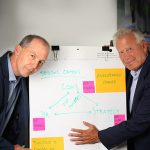As a Leader, Do You Really Trust Your People?

Leadership
September 7, 2018
Jim Haudan and Rich Berens
Topics
consistency, creativity, freedom, TrustWhether you lead teams of five, 25 or 105,000 people, the level of trust you give goes a long way to determining the success of your organization.
Trust is one of the top five leadership “blind spots” our research has shown to be an inhibitor of engagement and performance.
You and your organization want and need to deliver great service to differentiate yourself. The common belief is that the best way to deliver this is to create tight processes, scripts, and routines that minimize variability—to hold people and their behaviors to a strict policy and uniform standards.
But that approach – based on a lack of trust – never creates a consistent yet unique, differentiated, and personalized experiences that leads the market. It turns out that inviting and encouraging human variability is exactly what creates exceptional customer experiences.
As leaders, we often don’t trust our people
One client, one of the largest restaurant chains in the world, is a great example of the consequences a lack of trust in the judgment of your people to maximize performance at the restaurant level. Top-performing restaurants generated $2 million a year in revenue, while the average restaurants only generated $1.2 million a year. And this was for restaurants in comparable demographic areas.
After some soul-searching discussion and insightful research, the leadership team discovered that the middle-performing restaurants focused extensively on controls and compliance policies, just as they had been told. These restaurants made sure they hit their control numbers, regardless of the business.
However, the high-performing restaurants went a bit off script and focused primarily on two things:
- developing people and allowing those “developed people” great leeway in making decisions that were best for their customers; and
- focused on growing revenue rather than being totally preoccupied with cost controls that dominated the focus of the average-performing restaurant.
Optimizing Framework and Freedom
To survive and thrive at an elevated level, leaders must create a culture that focuses on both framework and freedom. Let’s break down each in more detail.
There are two forms of framework: One is driven by purpose and values, and the second is a framework of rules and policies.
The Framework of Purpose and Values: The values-based framework often starts with purpose. The purpose-centered approach assumes that most of us are inspired to be part of something bigger than ourselves and make a difference in the world around us.
The Framework of Rules and Policies: A number of industries and organizations that require consistency of process for safety, security, and a differentiated customer experience to achieve predictable outcomes also have a framework that is driven by rules and policies. These industries include transportation, restaurant, hospitality, manufacturing, pharmaceutical, and entertainment.
Freedom invites individual creativity and discretionary effort. It trusts people to bring their best talents and skills to the opportunity to contribute to an organization or a winning team. Trust is based on the belief that once the context (the why and what) is defined, people have an amazing ability to respond with care, compassion, and creativity (the how) to deliver exceptional outcomes.
Note that, it can be confusing to people to have both a framework and a freedom approach. To clarify, let’s describe framework and freedom in terms of hard lines, guidelines and no lines:
- Hard lines (All Framework) are the areas where there is one organizational way of doing things—no exceptions. It is where a rule, a procedure, or a behavior is clearly defined, and we expect everyone in the organization to abide by it. There is no gray space.
- Guidelines (Part Framework and Part Freedom) come with “guardrails.” Here boundaries are defined as firm, but how things get done between the guardrails is up to the individual. Guidelines are designed to be helpful and can be applied to areas like time and dollars or can be specific to an approach. With guidelines, you define expectations and provide guiding principles but leave the details of the “how” to the people executing it.
- No lines (All Freedom) involves inviting people to use their special talents to do things as they see fit. No matter the situation, employees are free to solve problems in any way they deem appropriate— and are even encouraged to think outside the box.
Invite uniqueness
It is the job of the leader to invite that uniqueness of each person to be part of the work experience every day. The key is to help people understand that we need to eliminate human variability on the “hard lines” to be consistent, and to add human variability where there are “no lines” to add the individual care and judgment that create better results.






